Why you can trust Tom's Hardware
XFX Radeon RX 7700 XT QICK 319
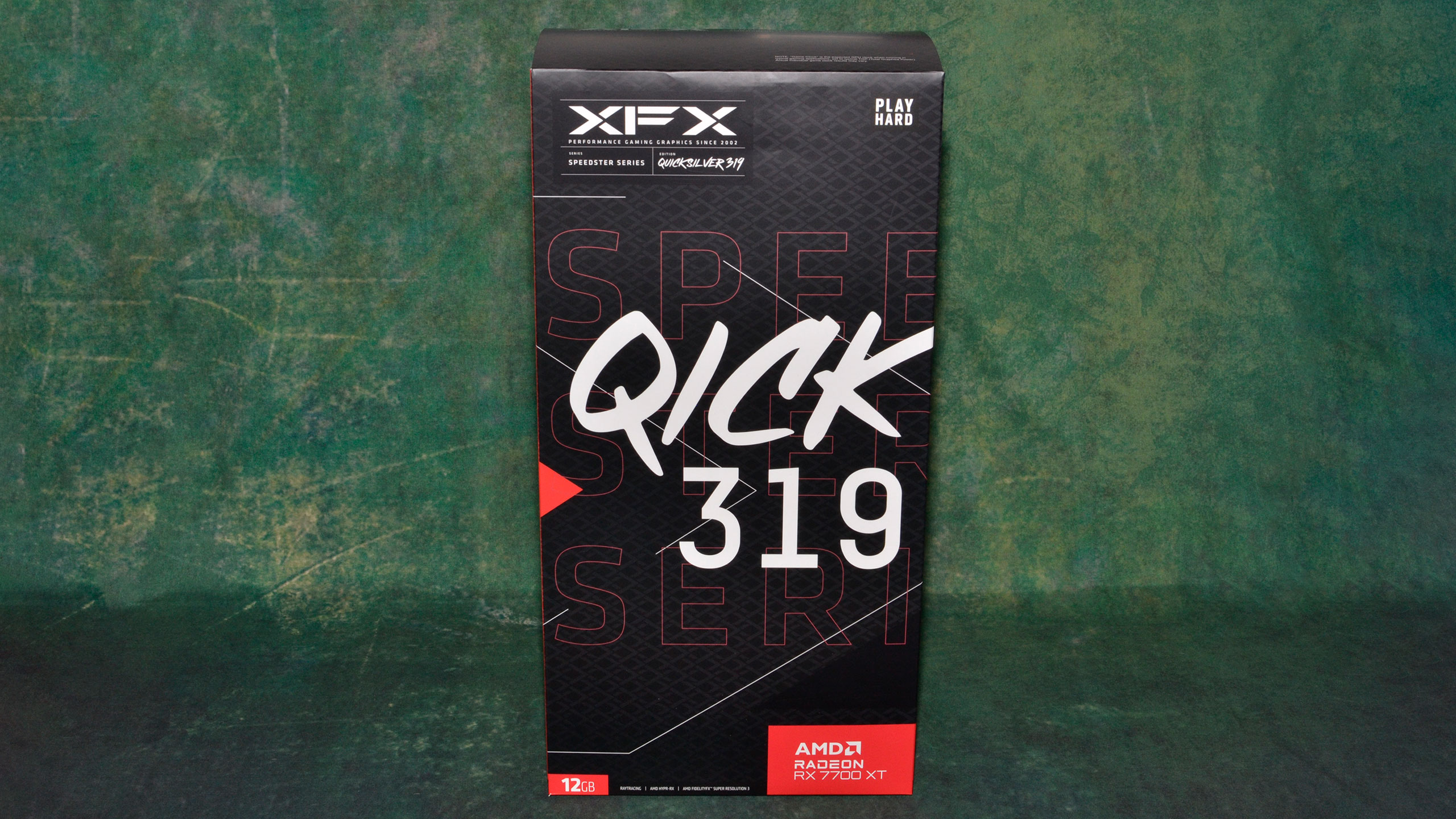
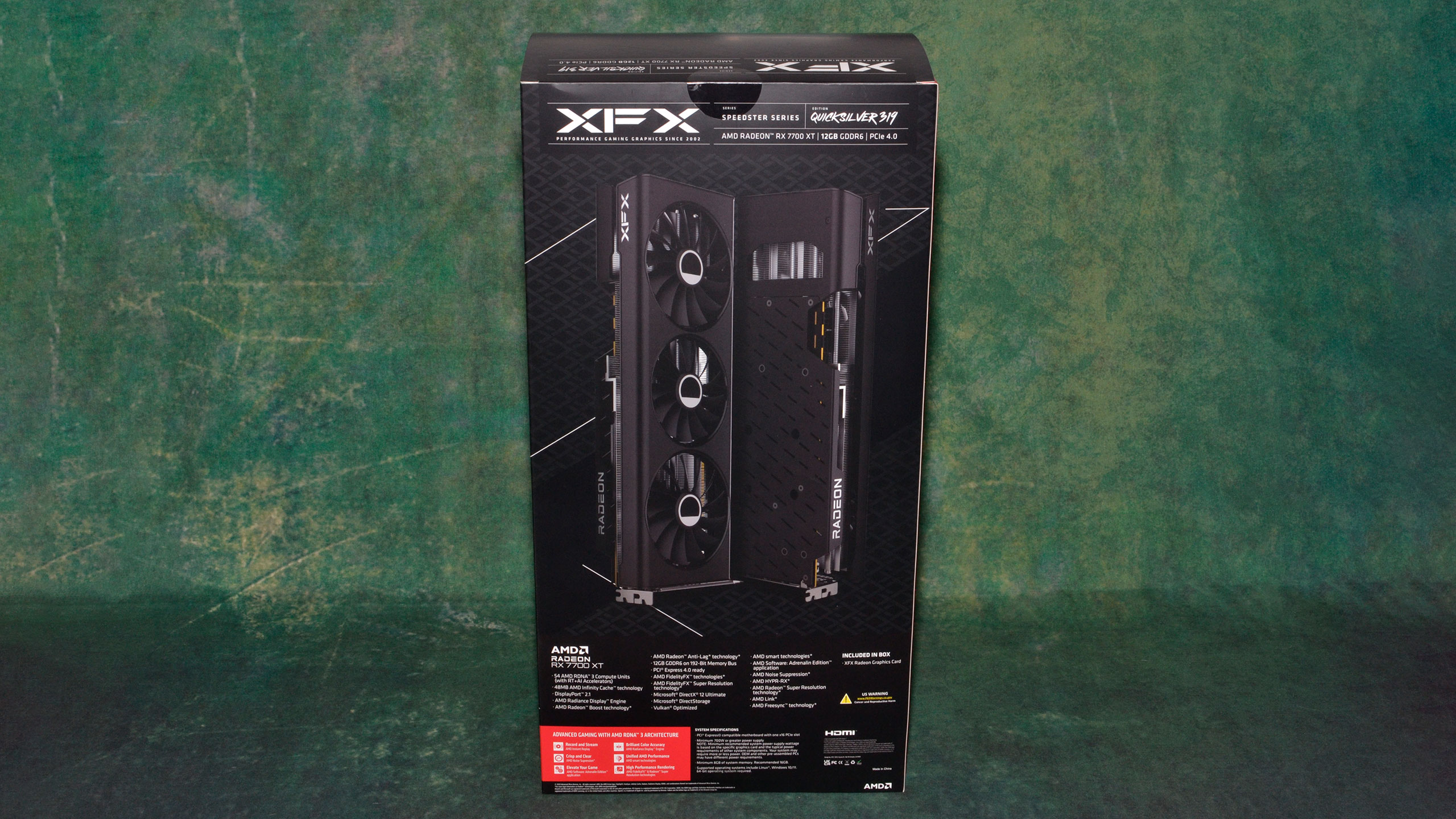

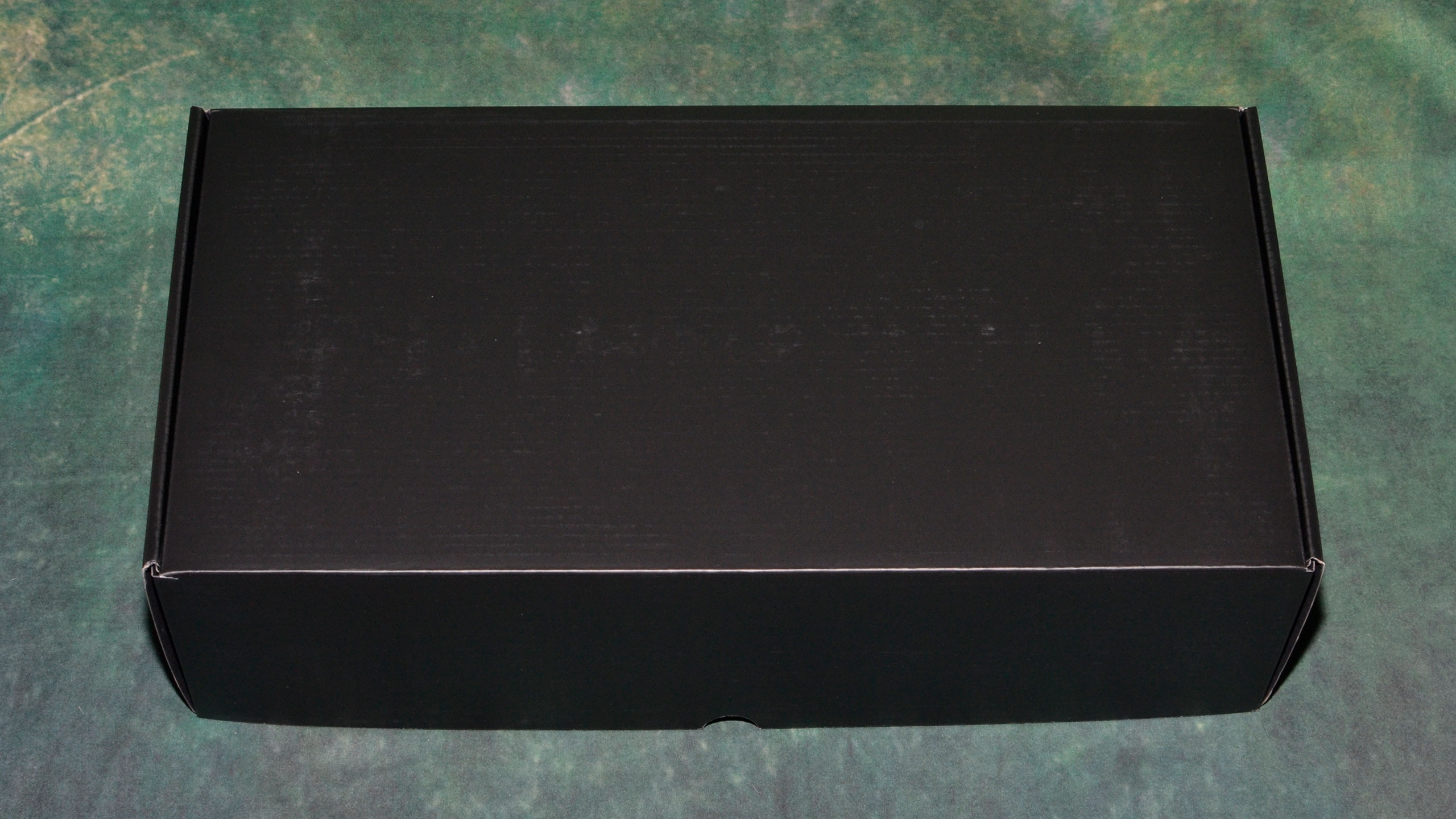
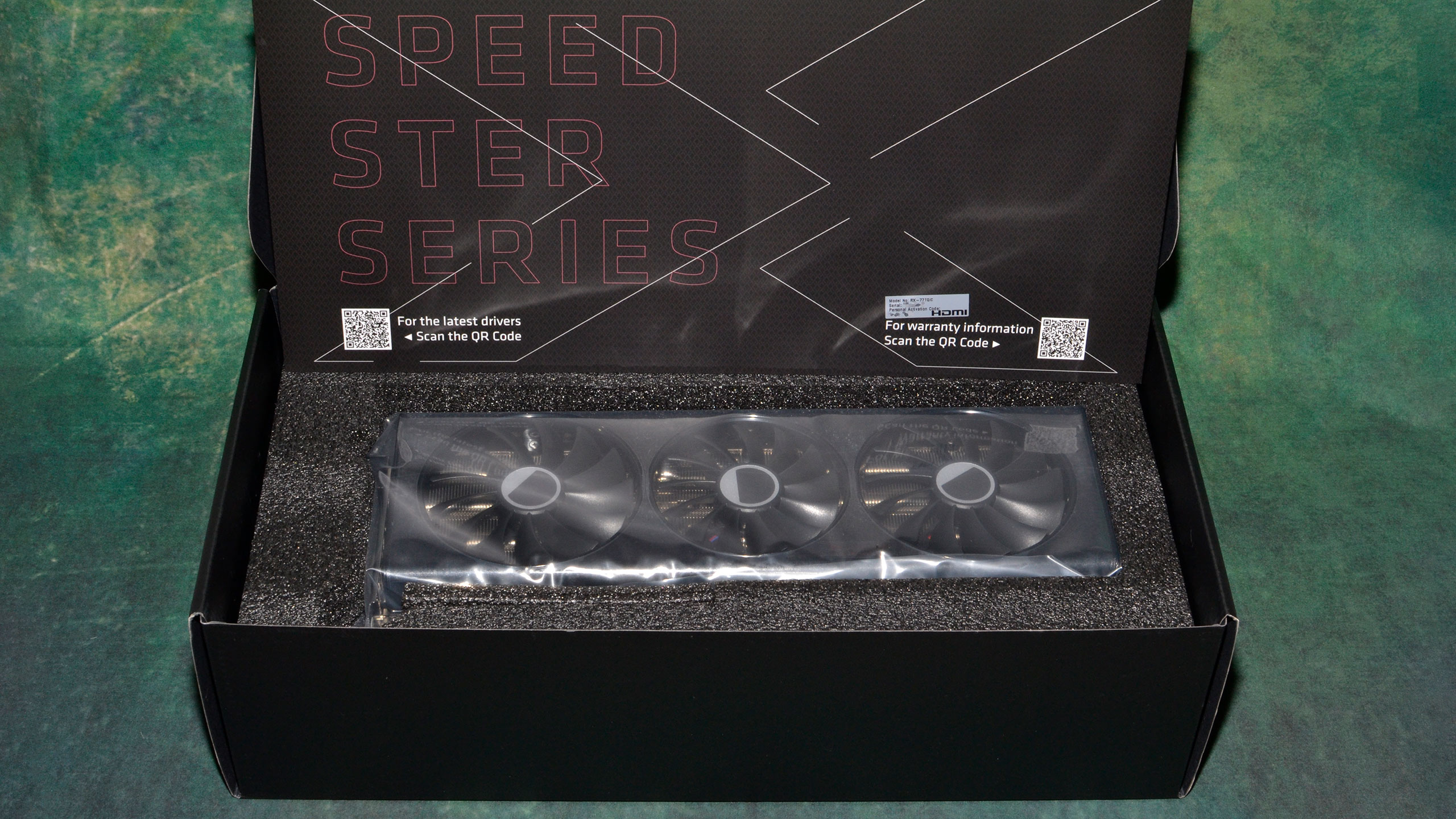


As noted already, there's no AMD reference RX 7700 XT. We received the XFX RX 7700 XT QICK 319 for this review, which should be fairly representative of what we'll see from baseline 7700 XT models.
One thing that immediately stands out is the size of the XFX card, especially as we've been testing the reference RX 7800 XT at the same time. It's very large for a "mainstream" card, probably larger than it needs to be. But if you're not using a compact case, what else are you going to do with all that space?
XFX goes the standard route with packaging as well, which means lots of empty space in the box. That should keep the card safe during shipping, but we definitely think the toned-down AMD and Nvidia packaging on reference models should be more commonly used by the AIB partners.

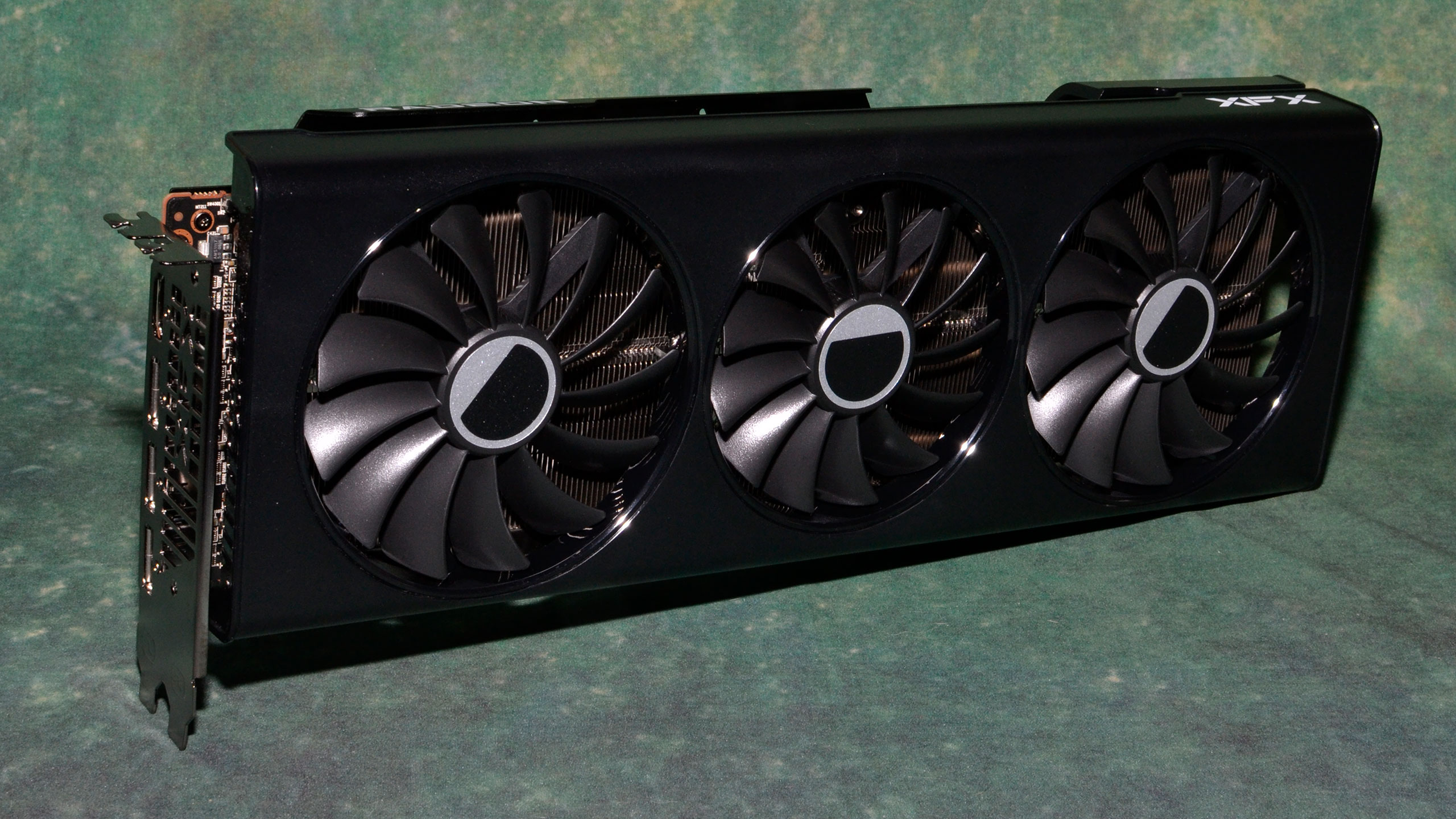
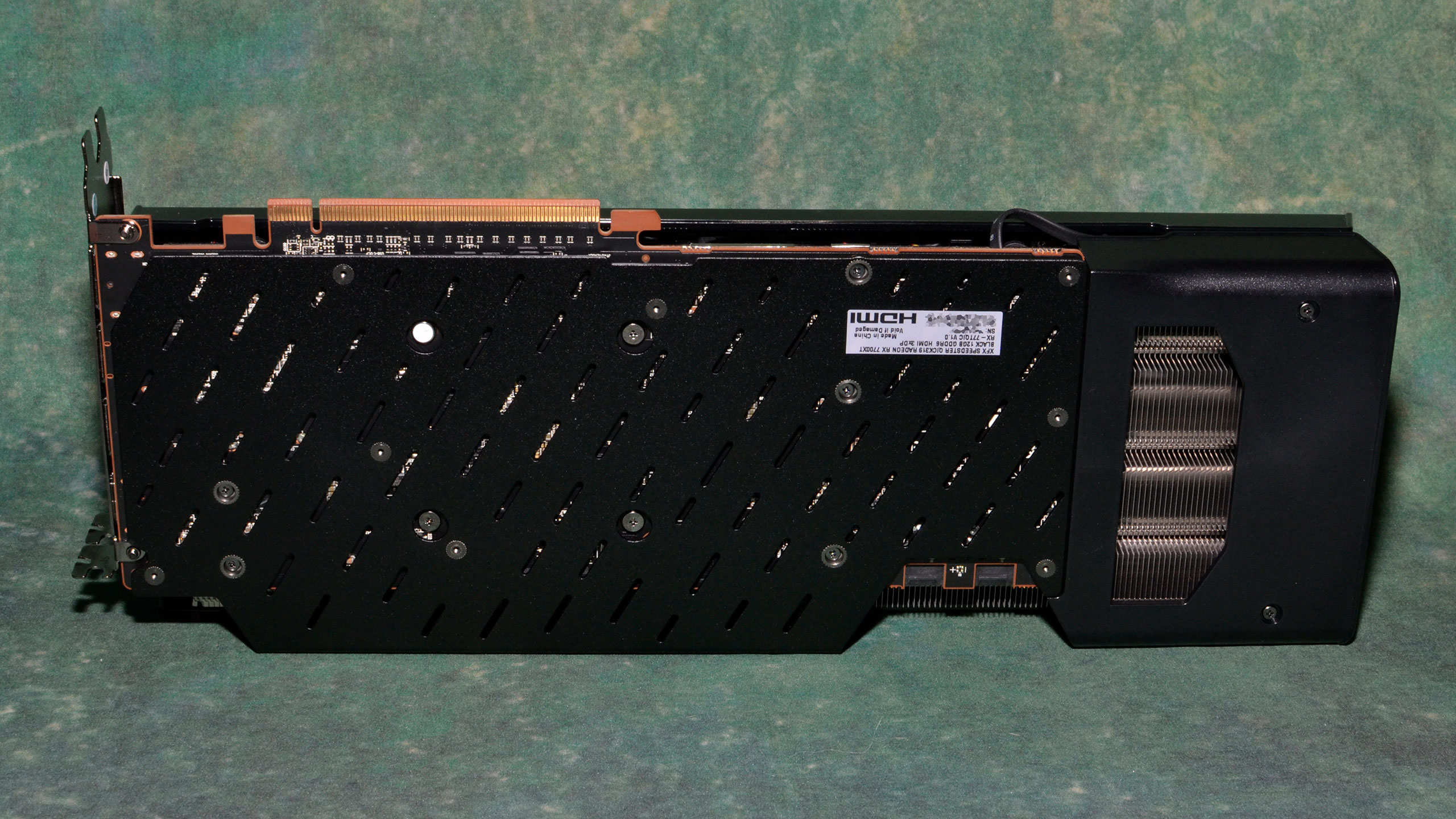

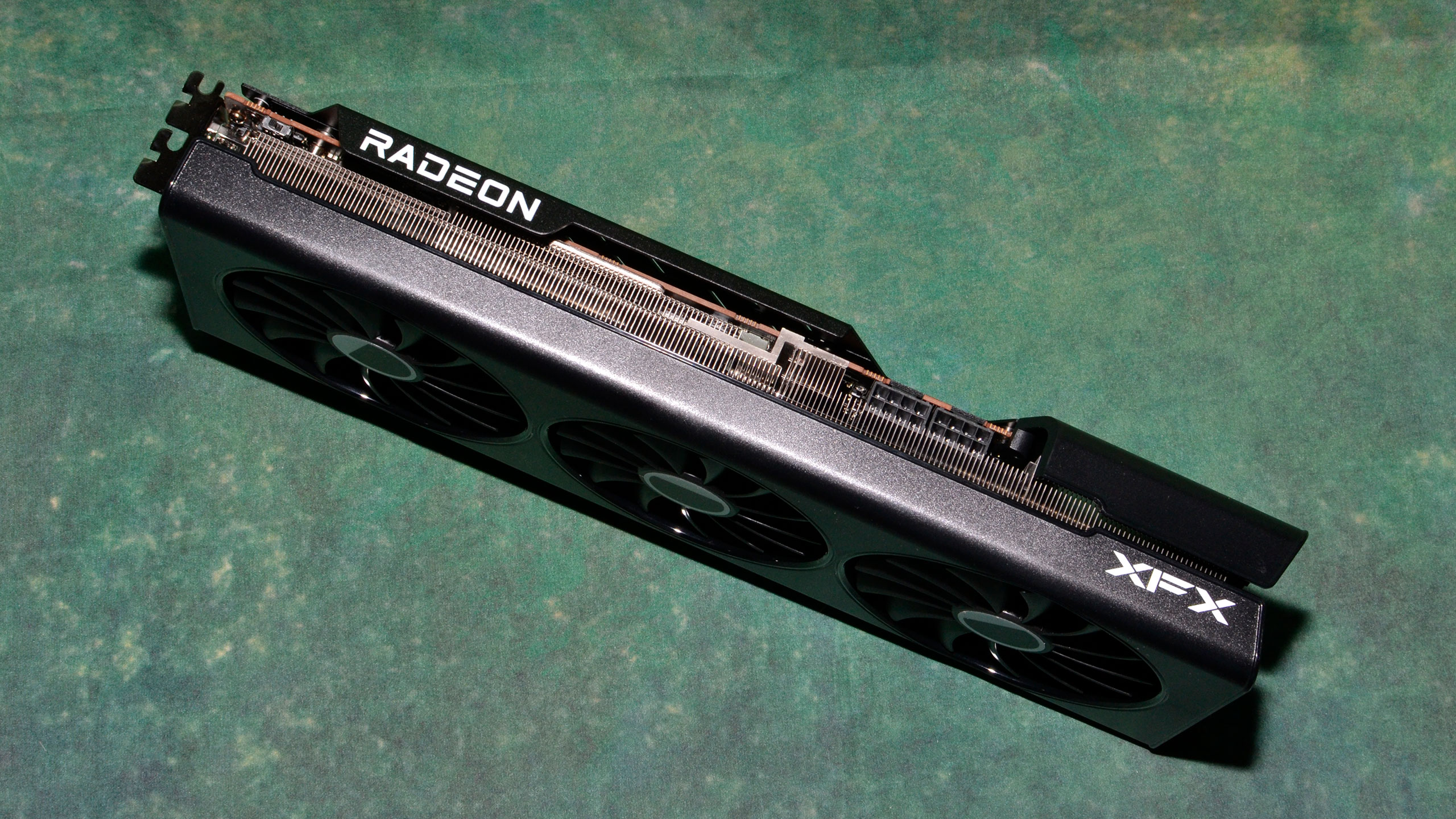

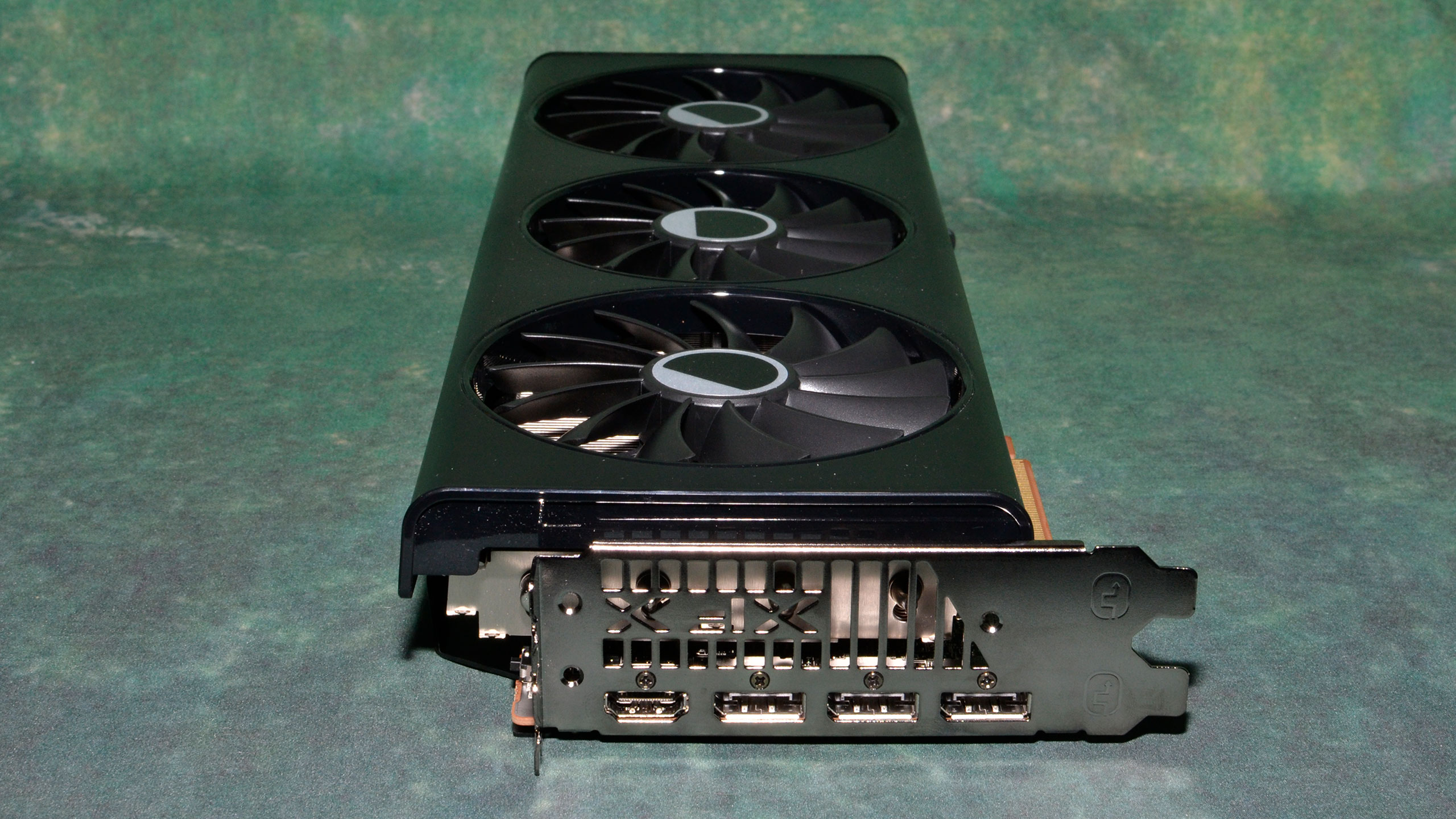




The XFX RX 7700 XT measures 339x129x50 mm, almost into RTX 4080/4090 as far as dimensions go. Even so, the card isn't particularly heavy, weighing just 1111g — 4g more than the 7800 XT reference card, if you're keeping score. Basically, XFX is using a lot of volume and triple fans to provide more than sufficient cooling, which means the card should generally run cool and quiet — and it does.
XFX has three fans, with two 94mm fans on the outside, and an 84mm fan in the center. The fans don't have integrated rims, which tends to be a higher quality design, but they're large enough and the card's 245W TBP (total board power) is low enough that it shouldn't matter too much.
Like the RX 7800 XT, the 7700 XT comes with dual 8-pin power connectors. That's not strictly necessary as an 8-pin plus 6-pin combination, combined with the PCIe slot, should be able to provide up to 300W of power. Still, 8-pin connectors are pretty ubiquitous now, and it's safer to not inadvertently end up with a card that pulls too much power from the x16 slot.
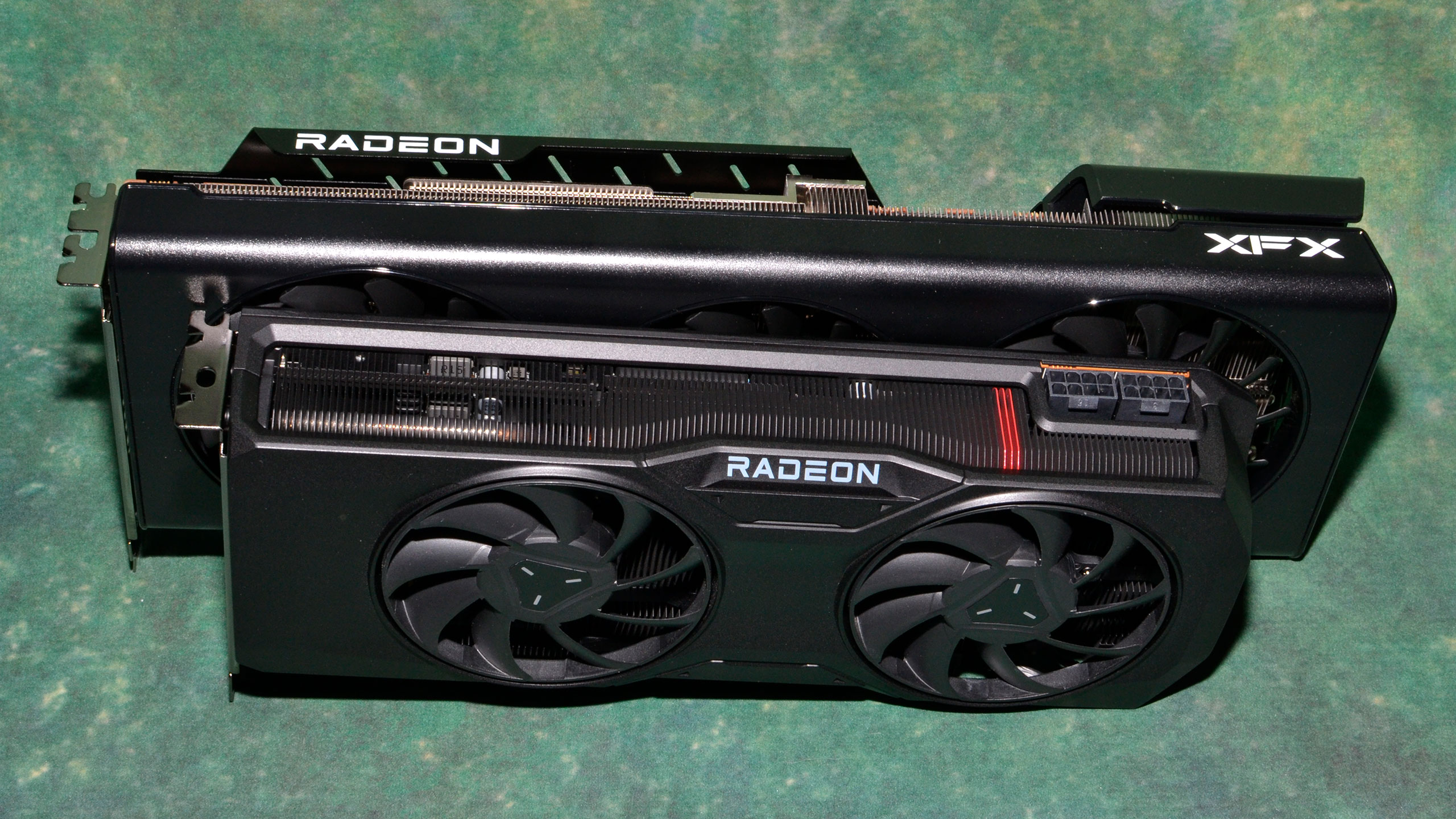
We mentioned the relative size of the card, and this shot hopefully puts things into better perspective. The 7800 XT reference card looks almost tiny by comparison, though we anticipate there will be plenty of compact 7700 XT designs from other vendors.
There's no RGB lighting or other bling on the XFX cards, so this is as barebones as it gets. The only real extra is a switch near the IO bracket that selects quiet or performance mode. In terms of IO, you get the standard single HDMI 2.1 port and triple DisplayPort outputs.
XFX RX 7700 XT Overclocking

This is going to be a short section, as our overclocking attempts with the XFX card basically ended in frustration. We normally start by maxing out the power limit and then attempt to dial in stable core and memory overclocks. We repeatedly ended up with a green screen and a crashed GPU after even minor changes.
It goes further than that. AMD's Radeon Settings feature auto-overclocking options for tuning the memory and GPU clocks, or you can go full manual. These are usually pretty conservative, but even clicking the auto-overclock RAM and GPU options resulted in problems.
Given we couldn't even dial in a 50 MHz core or GDDR6 overclock without issues, we decided to call it quits and move on. Whether it's our particular sample card, or something with RX 7700 XT in general, we can't say. But overclocking of RDNA 3 cards in general hasn't been all that great in our experience.
AMD Radeon RX 7700 XT Test Setup
We updated our GPU test PC at the end of last year with a Core i9-13900K, though we continue to also test reference GPUs on our 2022 system that includes a Core i9-12900K for our GPU benchmarks hierarchy. (We'll be updating that with the 7800/7700 XT numbers shortly.) For this review, we use the 13900K results for gaming tests, which ensures, as much as possible, that we're not CPU limited. We also use the 2022 PC for AI tests and professional workloads.
TOM'S HARDWARE 2023 Gaming PC
Intel Core i9-13900K
MSI MEG Z790 Ace DDR5
G.Skill Trident Z5 2x16GB DDR5-6600 CL34
Sabrent Rocket 4 Plus-G 4TB
be quiet! 1500W Dark Power Pro 12
Cooler Master PL360 Flux
Windows 11 Pro 64-bit
TOM'S HARDWARE 2022 AI/ProViz PC
Intel Core i9-12900K
MSI Pro Z690-A WiFi DDR4
Corsair 2x16GB DDR4-3600 CL16
Crucial P5 Plus 2TB
Cooler Master MWE 1250 V2 Gold
Corsair H150i Elite Capellix
Cooler Master HAF500
Windows 11 Pro 64-bit
GRAPHICS CARDS
AMD RX 7800 XT
AMD RX 7700 XT
AMD RX 6950 XT
AMD RX 6900 XT
AMD RX 6800 XT
AMD RX 6800
AMD RX 6750 XT
AMD RX 6700 XT
Intel Arc A770 16GB
Nvidia RTX 4070
Nvidia RTX 4060 Ti 16GB
Nvidia RTX 4060 Ti
Nvidia RTX 4060
We're using AMD's preview drivers (basically 23.8.2 but with support for the Navi 32 GPUs) for this review. Most of the results from other cards are from the past few months, and we've retested a few specific games where there were apparent anomalies in performance. We also retested Minecraft on every GPU over the past few weeks, as we found forcing vsync off in the game's Options.txt file improved performance by 10% or more on most GPUs (with Intel Arc being the biggest beneficiary).
We're including current generation and previous generation AMD hardware in our charts, with GPUs nominally priced between about $600 and $300. The same price bracket applies to the Nvidia and Intel GPUs, though we're not including RTX 30-series parts here. (If you want to see RTX 30-series results, check our GPU benchmarks or the RTX 4060 Ti 16GB review.)
Our current test suite consists of 15 games. Of these, nine support DirectX Raytracing (DXR), but we only enable the DXR features in six games. The remaining nine games are tested in pure rasterization mode. While many of the games in our test suite support upscaling — twelve support DLSS 2, five support DLSS 3, and five support FSR 2 — due to time constraints we've skipped upscaling tests here. (Keep in mind that we have both the 7700 XT and 7800 XT launching today, so there were more tests to run over the past week or so than usual.)
As with the RTX 4060 Ti 16GB review, we're also including a few additional games with limited testing: F1 2023, Hogwarts Legacy, and The Last of Us: Part 1. Just for kicks, we're also showing Starfield performance, even though Nvidia performance appears seriously poor right now. These extra games are not factored into the overall performance ranking but are more for those who want to see some newer titles.
We tested the RX 7700 XT at 1080p (medium and ultra), 1440p ultra, and 4K ultra — ultra being the highest supported preset if there is one, and in some cases maxing out all the other settings for good measure (except for MSAA or super sampling). We'll only have limited commentary on the 4K results, as the RX 7700 XT doesn't do too well at that resolution. It primarily targets 1440p gaming, according to AMD, or even 1080p.
Our PC is hooked up to a Samsung Odyssey Neo G8 32, one of the best gaming monitors around, allowing us to fully experience some of the higher frame rates that might be available. G-Sync and FreeSync were enabled, as appropriate. As you can imagine, getting anywhere close to the 240 Hz limit of the monitor proved difficult, as we don't have any esports games in our test suite.
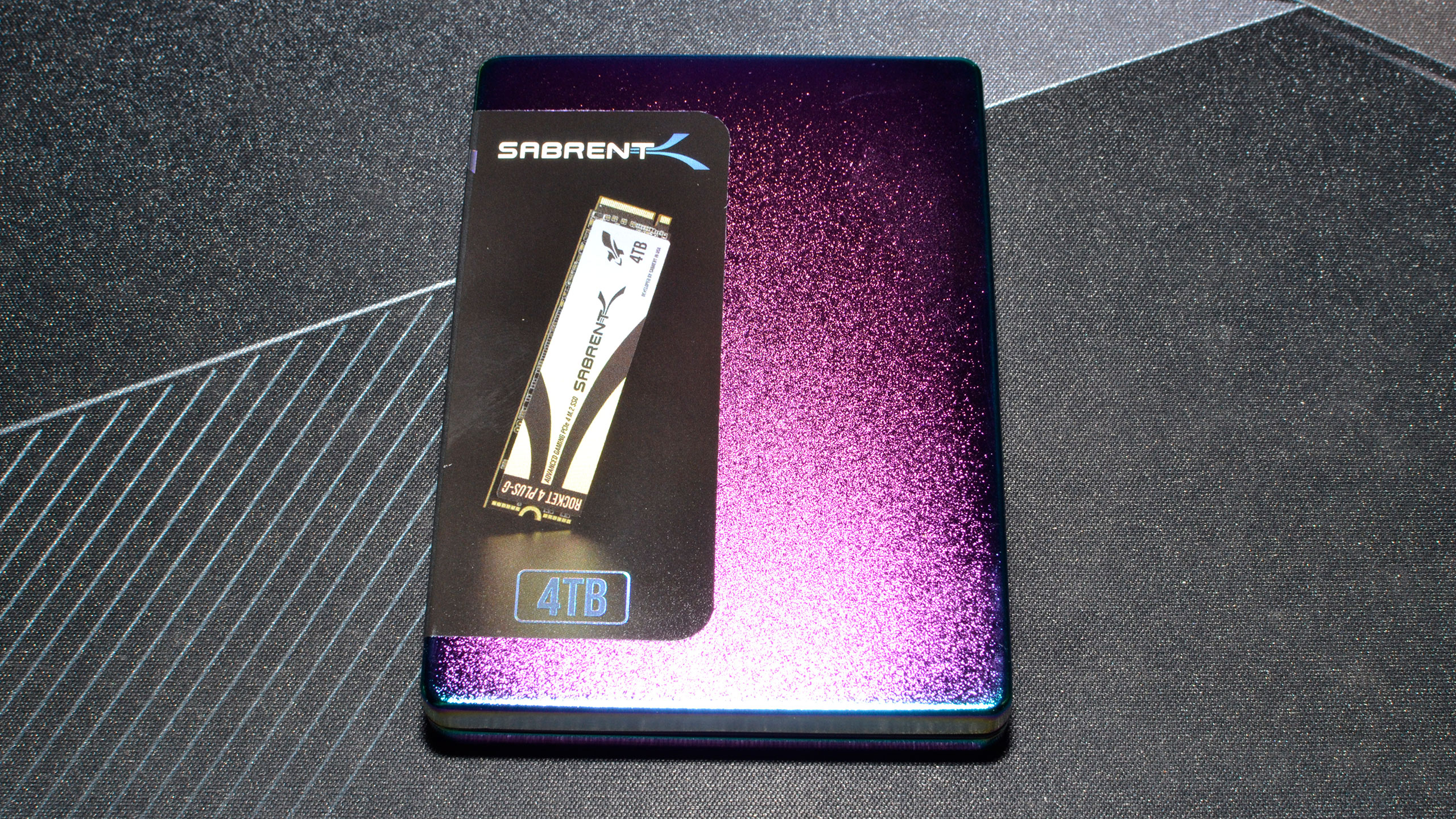
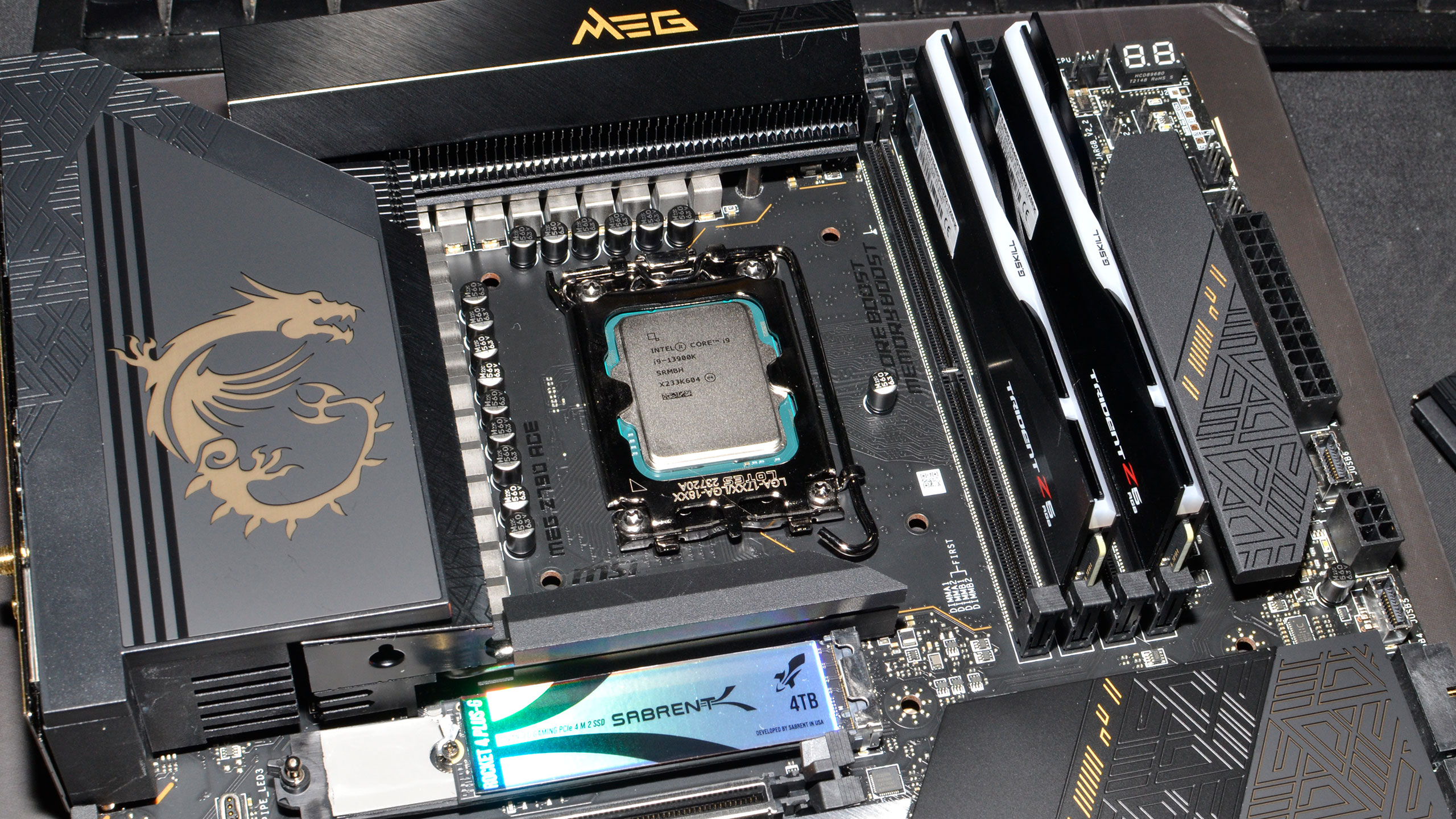
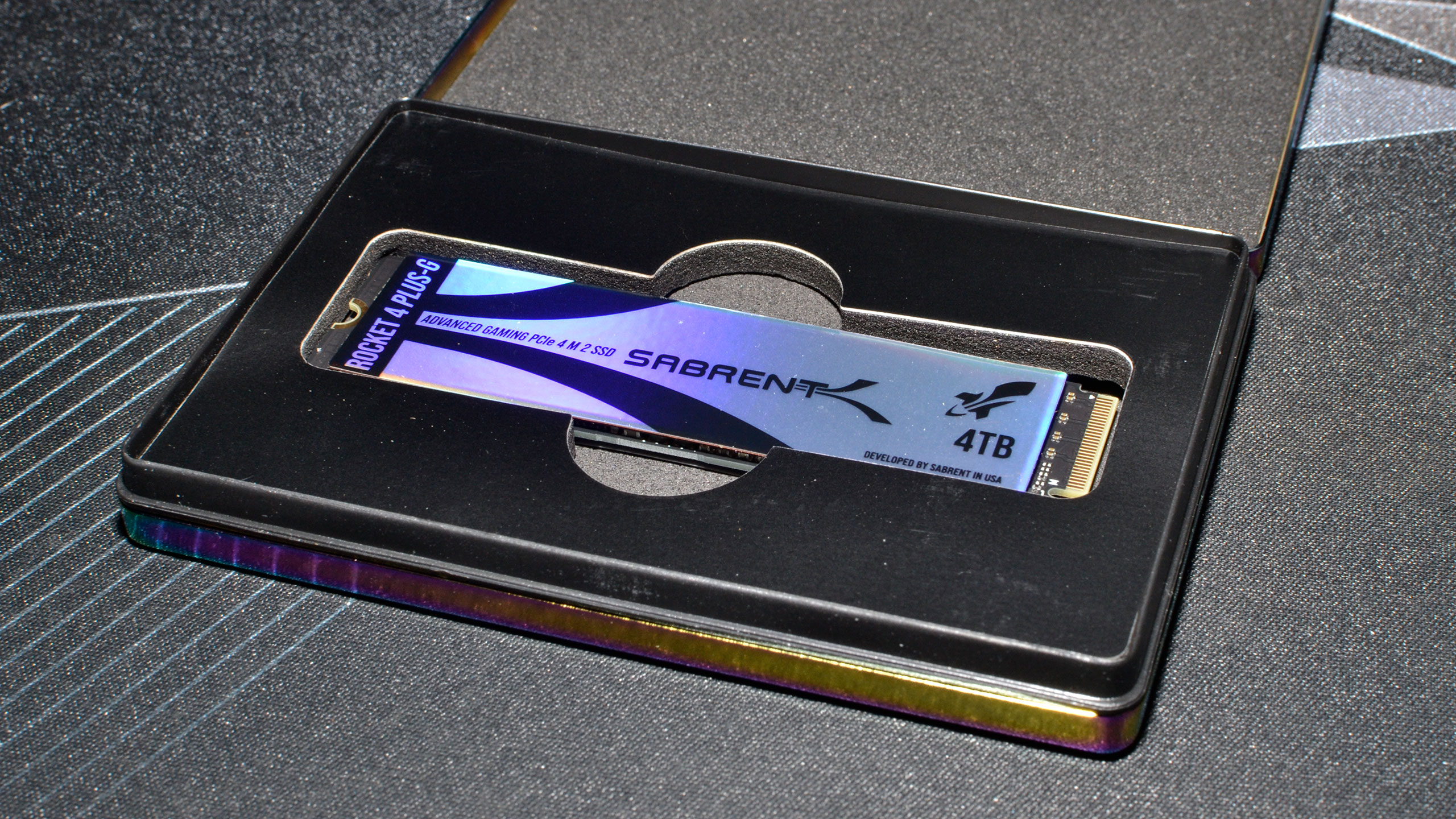
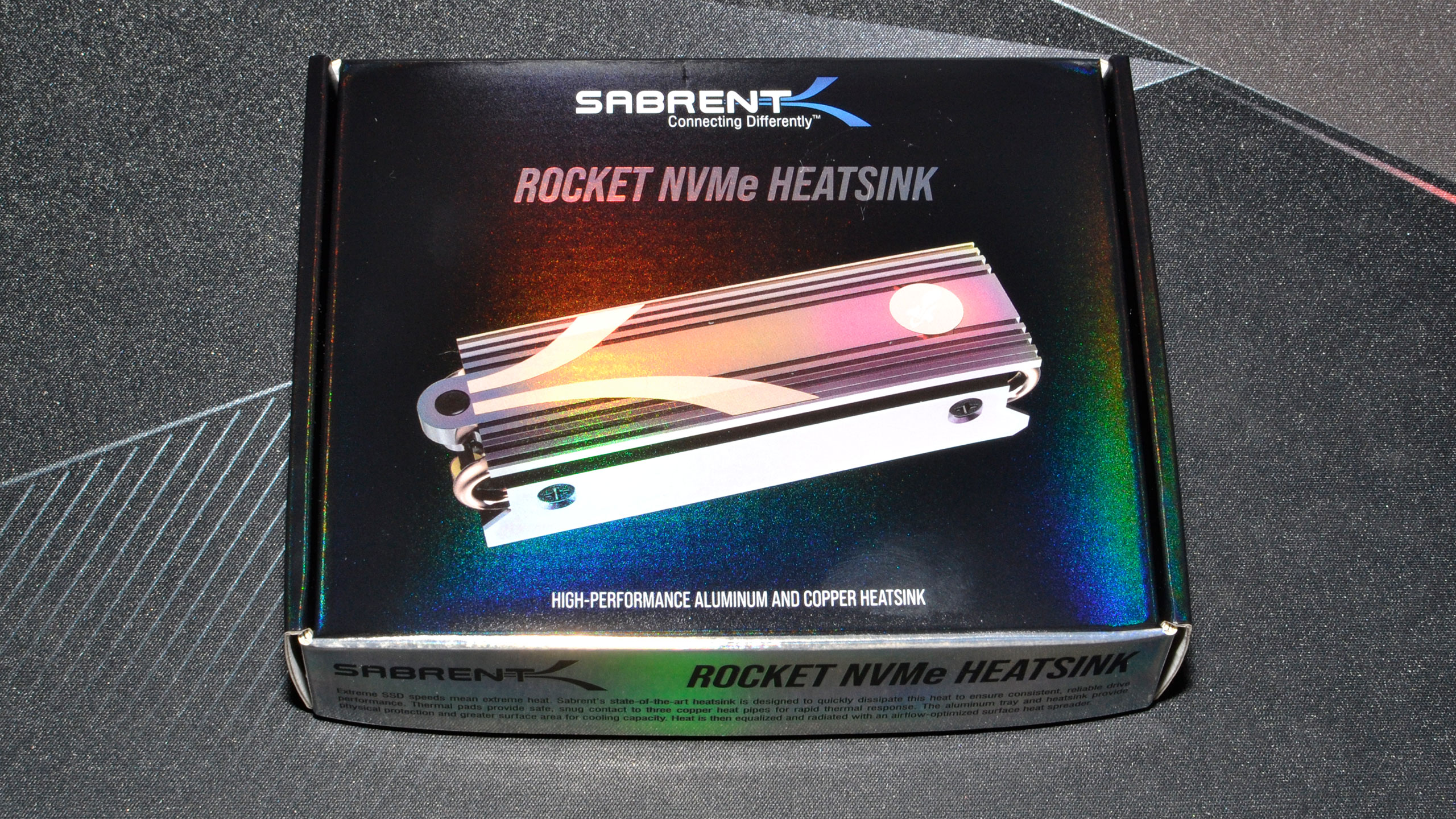


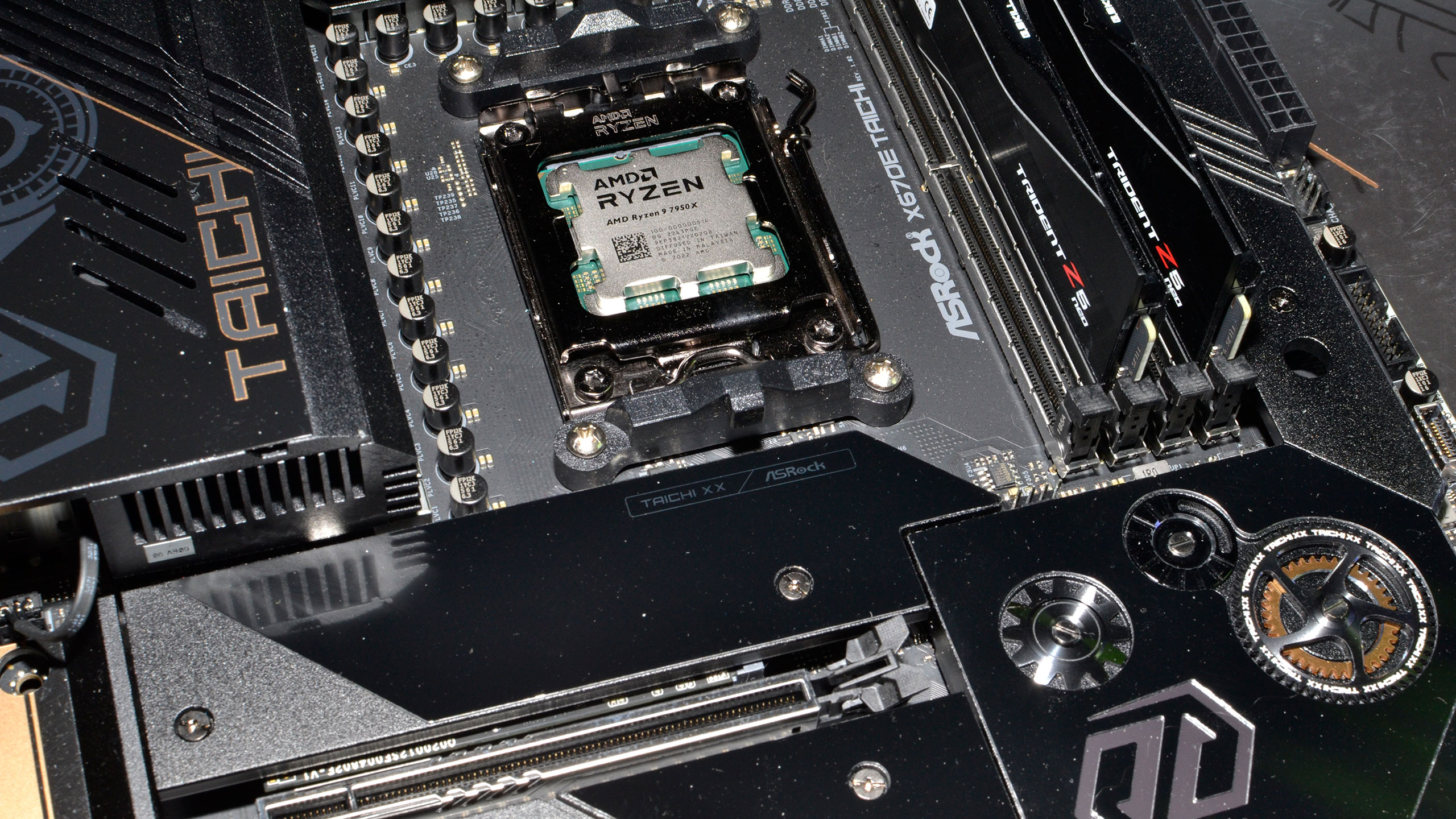
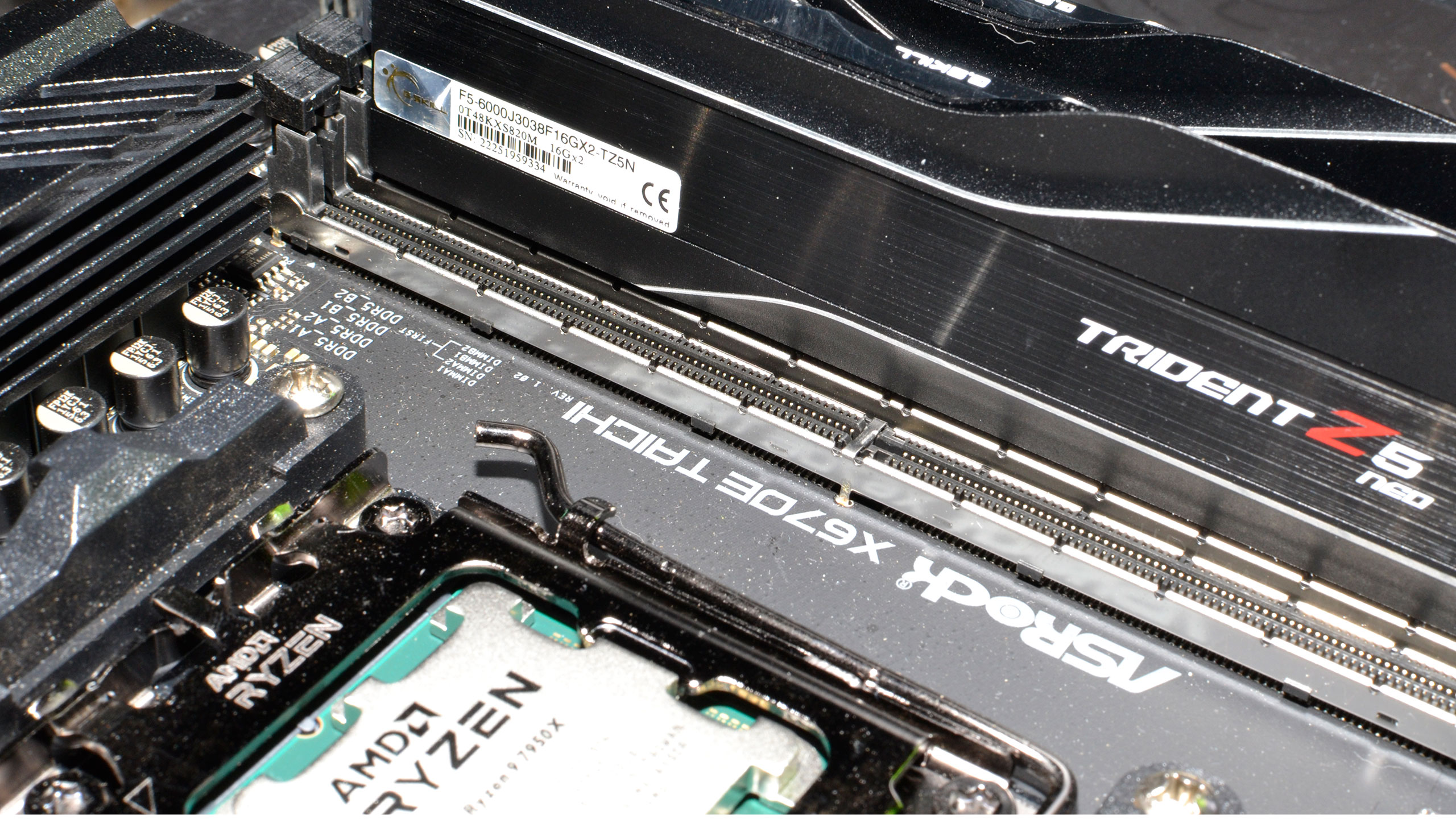
We installed all the then-latest Windows 11 updates when we assembled the new test PC. We're running Windows 11 22H2, but we've used InControl to lock our test PC to that major release for the foreseeable future (though critical security updates still get installed monthly).
Our new test PC includes Nvidia's PCAT v2 (Power Capture and Analysis Tool) hardware, which means we can grab real power use, GPU clocks, and more during all of our gaming benchmarks. We'll cover those results on our page on power use.
Finally, because GPUs aren't purely for gaming these days, we've run some professional application tests, and we also ran some Stable Diffusion benchmarks to see how AI workloads scale on the various GPUs.
Get Tom's Hardware's best news and in-depth reviews, straight to your inbox.
- MORE: Best Graphics Cards
- MORE: GPU Benchmarks and Hierarchy
- MORE: All Graphics Content
Current page: XFX Radeon RX 7700 XT Card and Overclocking
Prev Page AMD Radeon RX 7700 XT Review Next Page Radeon RX 7700 XT: 1440p Ultra Gaming Performance
Jarred Walton is a senior editor at Tom's Hardware focusing on everything GPU. He has been working as a tech journalist since 2004, writing for AnandTech, Maximum PC, and PC Gamer. From the first S3 Virge '3D decelerators' to today's GPUs, Jarred keeps up with all the latest graphics trends and is the one to ask about game performance.
-
cknobman This card will be a winner when the price is reduced to $400.Reply
Between this card and its bigger brother, the 7800XT, Nvidia's 4060 series of cards (and maybe even the 4070) are completely irrelevant now. -
oofdragon Replycknobman said:This card will be a winner when the price is reduced to $400.
Between this card and its bigger brother, the 7800XT, Nvidia's 4060 series of cards (and maybe even the 4070) are completely irrelevant now.
I'd say the 7800XT will be a winner in a year or two when it's discounted at $400. The 7700XT at 12GB is more like.. $300. -
Colif Both cards released make the 4060 TI even more of a joke than it was already.Reply
5TGHvXKkhao
The price difference is bigger in other countries, it makes more sense there.
7800xt in Australia is about $1000
7700xt in Australia is about 860
7800xt selling out fast so 7700xt might be only choice for a few weeks in some places. -
JarredWaltonGPU Reply
Does it, though?Colif said:Both cards released make the 4060 TI even more of a joke than it was already.
The price difference is bigger in other countries, it makes more sense there.
7800xt in Australia is about $1000
7700xt in Australia is about 860
7800xt selling out fast so 7700xt might be only choice for a few weeks in some places.
272
So 20% faster in rasterization, 8–10 percent slower in DXR, uses 60W more power, costs 12.5% more. The 128-bit and 8GB is a concern, sure, but it's absolutely not the end of the world. Turn down settings to high and it's fine, even at 1440p.
7800 XT makes for a bigger gap, and that's definitely the better card of the 4060 Ti/7700 XT/7800 XT class. But the 7700 XT isn't a clear-cut winner in every situation: Higher power, worse RT, worse AI hardware, higher cost. -
P1nky Reply
Can't believe you're actually defending the 4060 Ti, a GPU with just 8GB for a massive $400 price. No wonder you gave the 7700 XT a meh rating.JarredWaltonGPU said:So 20% faster in rasterization, 8–10 percent slower in DXR, uses 60W more power, costs 12.5% more. The 128-bit and 8GB is a concern, sure, but it's absolutely not the end of the world. Turn down settings to high and it's fine, even at 1440p.
7800 XT makes for a bigger gap, and that's definitely the better card of the 4060 Ti/7700 XT/7800 XT class. But the 7700 XT isn't a clear-cut winner in every situation: Higher power, worse RT, worse AI hardware, higher cost.
You must watch HU's investigation of how bad the textures look on just 8GB, even if the framerates are unaffected. There are plenty of games that won't be bottlenecked by 8GB by 30 second benchmark runs. Cards might performs similarly sometimes, but the texture experience and frame drops on on 4060 Ti are a joke on long benchmark runs. -
luissantos ReplyJarredWaltonGPU said:So 20% faster in rasterization, 8–10 percent slower in DXR, uses 60W more power, costs 12.5% more. The 128-bit and 8GB is a concern, sure, but it's absolutely not the end of the world. Turn down settings to high and it's fine, even at 1440p.
7800 XT makes for a bigger gap, and that's definitely the better card of the 4060 Ti/7700 XT/7800 XT class. But the 7700 XT isn't a clear-cut winner in every situation: Higher power, worse RT, worse AI hardware, higher cost.
Your only valid point is power consumption.
DXR performance is mostly irrelevant: neither card is sufficiently capable in that regard. Until DXR comes with a 5-10% penalty in performance it will remain a gimmick. In fact, games that have had a "modern render release" like Quake 2 look far better using said new render than DXR. For CP2077 I'm sure I could find plenty of scenes where I could take a screenshot with RT on and off and trick you into guessing incorrectly. Moreover, UE 5's Lumi produces reasonably similar results with RT on and off, and that engine will have the most coverage of any other in the game market for the years to come.
As for AI, just a few weeks ago AMD announced huge strides in that field as well, but again, that's irrelevant. What percentage of the market is buying a consumer mid-range GPU to focus primarily (or at all) on AI? -
JarredWaltonGPU Reply
The texture stuff is mostly game specific. Some games (Gollum, Star Wars, and basically a lot of Unreal Engine stuff) do a poor job at managing VRAM and so when the game exceeds 8GB, they load minimum res on some surfaces and not others. Then you get "texture popping" and stuttering. It's frankly a bad game engine design. Lots of other games exist that look very good and don't have the same problem, so it's pretty much a matter of coding quality and effort.P1nky said:Can't believe you're actually defending the 4060 Ti, a GPU with just 8GB for a massive $400 price. No wonder you gave the 7700 XT a meh rating.
You must watch HU's investigation of how bad the textures look on just 8GB, even if the framerates are unaffected. There are plenty of games that won't be bottlenecked by 8GB by 30 second benchmark runs. Cards might performs similarly sometimes, but the texture experience and frame drops on on 4060 Ti are a joke on long benchmark runs.
The solution is to turn texture and shadow resolution down a notch, which usually drops VRAM use from <12GB to <8GB and rarely has a noticeable impact on visuals. Except some games (again, UE especially) don't even seem to do this very well. Software optimizations, particularly with low-level APIs (DX12/Vulkan) can easily deliver a 50% boost in performance, sometimes more. It's just a matter of how much effort the developers / publishers want to expend.
I’m not saying 4060 Ti is great. I’m just pointing out that it’s not universally inferior to the 7700 XT / 7800 XT. 192-bit and 12GB or 256-bit and 16GB is inherently a superior configuration to 128-bit and 8GB/16GB. There's no question about that. But VRAM capacity and bandwidth aren't the only factor that matters. -
shady28 Agree this isn't all that impressive, but neither was the 4060 Ti. I bought a 6700XT last year, and after seeing the 4060 Ti I really have no regrets.Reply
This 7700XT doesn't really seem to change any of that. If it were say $399 instead of $450, it might be ok. It's kind of a trade off with the 4060 Ti, generally better on performance (but not always) while losing on gaming power draw, but costs $50 more, which is frankly not good enough for an AMD GPU.
Best deal on your comparison is still the 6700 XT. -
Ilijas Ramic Reply
In my country the price diff is around 140usd 7700xt vs 7800xt. I ordered 7700xt for 680usd while the 7800xt is 820usd. Its almost 3x more price diff what most people pay. Also most people buy from newegg since they are from US. But us EU people are getting a hefty pay up on these card. Heck the newegg price is 450usd for 7700xt while i have to pay 230usd more. I havent upgraded my gpu for like 8 years now. Heck i got r9 380 on release date. And i paid back than msrp US price here wich was shocking 200usd. But after that we got price diffs soo large i just couldnt afford to upgrade.Colif said:Both cards released make the 4060 TI even more of a joke than it was already.
5TGHvXKkhao
The price difference is bigger in other countries, it makes more sense there.
7800xt in Australia is about $1000
7700xt in Australia is about 860
7800xt selling out fast so 7700xt might be only choice for a few weeks in some places.